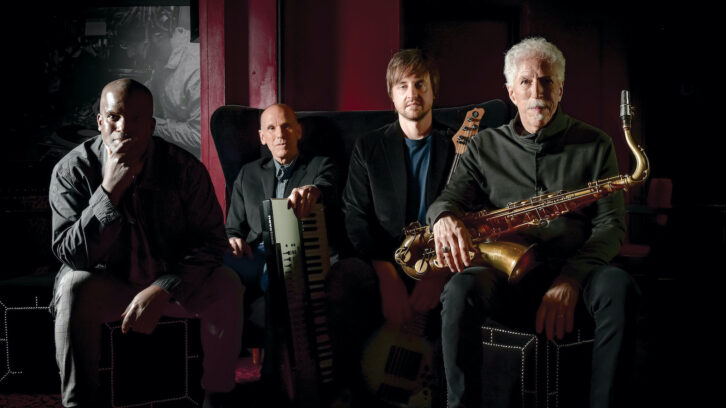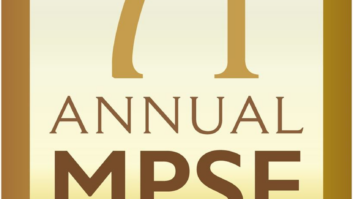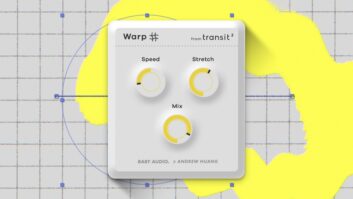
Los Angeles, CA (November 2, 2022)—After 26 records, the Yellowjackets still deliver the goods. Across 40 years, with accompanying personnel changes, pianist Russell Ferrante has remained the one constant, though the excellence of the music has endured from the beginning, yielding two Grammys and two more nominations.
From the release of Mirage a Trois in 1984 to the 2020 offering, Jackets XL (With the WDR Big Band), Yellowjackets never disappoint. Now add the recently released Parallel Motion to that remarkable lineage, with a stellar lineup that’s played together the past seven years: Ferrante, Bob Mintzer (tenor and soprano sax), Will Kennedy (drums) and Dane Alderson (electric bass). It begs the question, “How does a band continue to compose, create, stay enthused and remain current over four decades?”
“We’re all still trying to get better at what we do,” Ferrante says. “We’re studying, we’re traveling, playing festivals and encountering other musicians. Also, teaching. The students have turned us on to so many interesting younger musicians. All of those things come into play and carry over to live performance as well.”
The challenge with Parallel Motion turned out to be mostly in the scheduling, combined with COVID restrictions and the fact that Ferrante, Kennedy and Mintzer all teach full time at USC. With Alderson living in Virginia, they found themselves not able to rehearse as much as usual. It may sound corny, Ferrante says, but the joy was in just being together with his bandmates. They’re all friends.
“Working together with everyone and shaping the music was a highlight, along with working at Capitol Records,” Ferrante says. “The very first Yellowjackets recording was mixed at Capitol with Al Schmitt. This project was the first time we recorded there in 40 years.”
THE FIFTH JACKET
Engineer Rich Breen first worked with the band 27 years ago, doing some piecemeal jobs off and on. The first album he completely tracked was 1997’s Blue Hats; now he mixes and masters the group’s projects as well. He agrees with Ferrante’s assessment of the challenges, though he asserts that his job is fairly standard and can be summed up simply: “You’ve got four of the highest-caliber musicians in a room together. They’ve all been recording for decades now. They all know how to sound good in front of microphones. You put some mics up and you try not to get in their way, and if you don’t screw it up, it’s going to be good. And if you get the vibe right, it’s better than good.”
Capturing ‘Blues & Hues’ in Two Tracks, Part 1
Breen is underestimating his worth, as well as his contribution to 13 albums and counting, as Ferrante explains: “Rich is a musician— quite a good pianist and mandolin player. He’s interested in all kinds of music. In addition to having the musical side and artistic side, he’s a brainiac and techno wiz. He can pull apart a computer or a mixing console. He’s someone who is attuned to capturing instruments.
“He can get a great sound from an orchestra, a big band or a small jazz group,” Ferrante continues. “He understands mic placement like the old guys, like Al Schmitt did. He spends a lot of time and attention on the piano. He brings his own mics and has an incredible pair that he uses on the acoustic piano. Some of our music is complex, and Rich can read the charts.”
INSIDE CAPITOL
The Yellowjackets always bring in charts, and on this album, engineer Steve Genewick assisted. “He was extremely overqualified to assist,” Breen says with a laugh. They tracked live to Pro Tools HDX at 24-bit/96 kHz. “We’re basically just trying to mark out the form as they’re recording, because there will be multiple takes,” Breen says. “They’ll try different tempos, they’ll make form edits and that kind of thing. It’s a very democratic process with them. But they usually have it within three or four takes.”
Some songs, particularly Alderson’s, included pre-recorded material, which they would incorporate while tracking. If there were form edits—which there were—they did them on the spot and the band would re-record to the new forms. Breen’s choice of gear is generally similar from project to project, depending on the studio, of course. He also is likely to include a few from his own collection. “A band like this does not require tons of mics,” he says. “I tend to keep things pretty simple.”

The main tracking sessions took place over three days, including recording to Jean Baylor’s vocals that she sent in for the song “If You Believe,” which she co-wrote with Ferrante. One of Ferrante’s personal highlights came with the recent purchase of a Fazioli Grand Piano, which he had brought into Capitol. “That was really fun,” Ferrante says. “It was an unknown, because an instrument can sound wonderful in your living room, but when you bring it into a studio, there are some other factors.”
For Breen, the 7-foot Fazioli dictated a different sound treatment than what he does for Ferrante’s usual Yamaha 7- or 9-footer. “A Fazioli is a lovely instrument, but they are loud and tend to have a fairly aggressive top end,” he explains. “I chose Sennheiser MKH- 800s for the piano on this one, as they are a slightly warmer mic than DPA4011s, which I might normally choose for piano. I backed off as much as I could for the space the piano was in. The [Sennheisers] went to my hand-built—by me—mic preamps, which are an old Jensen design that is still my favorite and adds just the right amount of warmth to my ear. Then to a pair of GML8200 EQs, which I barely touched.”
“I think Rich was really pleased with the way it recorded, and that was different for us,” Ferrante says, adding that the instrument inspired his composition “Il Mio Amico” (“My Friend”). “Faziolis are made near Venice, Italy, so that tune is a tip of the hat to the instrument. The beautiful sound inspired some of the harmonies.”
MIXING FROM THE START
“At the session, we’re printing live mixes of everything; the band chooses takes at the session, and sometimes that involves parts of one take edited into another take,” Breen says. “When we’re finished, we pretty much have final edited takes. I’ll then provide those to the band members, who will sometimes add overdubs from home and send them back to me to incorporate into the final mix. This kind of workflow is really common these days.”
Breen mixes at his own Dogmatic Studio, all in the box: Pro Tools HDX, with three Avid S1 controllers, Avid Dock, monitoring on PMC IB1s with Bryston amps, and monitor control via Metric Halo ULN8. Breen says he started working completely in the box a few years ago.
“Everything got good enough,” he asserts. “When you’re tracking, there’s a lot of good gear available—preamps, a handful of GML stuff, compressors—so that’s all imprinted on the track. There’s just not that much to do. I guess the real difference in the last few years is how the reverbs have changed. These days, I’m very fond of LiquidSonics reverbs. They’re also great because they’re set up for Atmos and surround stuff.”
As for the future, Ferrante says the Yellowjackets just keep going, making Yellowjackets music and performing it as long as it feels right and they have something to express: “We want to keep upping our game with new things to say and new ways to say it.”







